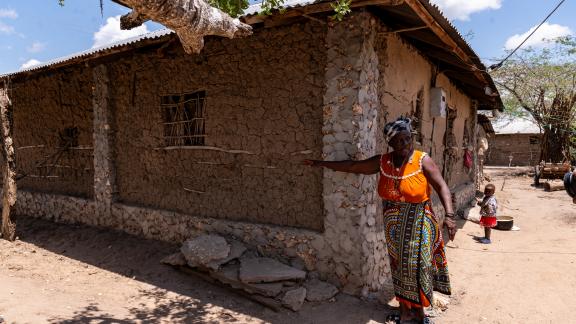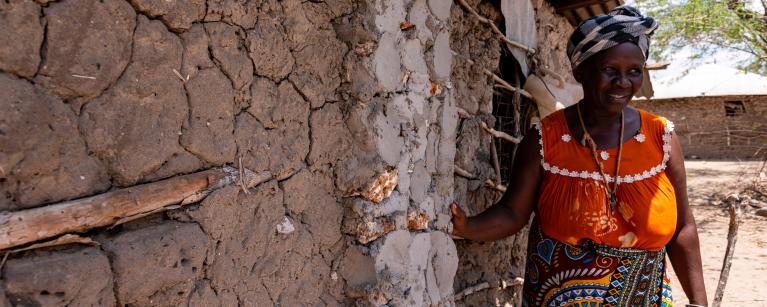In the heart of Tana River County, nestled within the vibrant village of Maziwa, lives Susana Habuya. Once a vibrant community, Maziwa is now etched with the scars of devastation left by the catastrophic floods that struck between March and May 2024. The relentless rains transformed the landscape, turning the Tana River into a raging torrent that would claim lives, livelihoods, and homes.
At Susana's home, the mud thatched houses bare testament to the wrath of the waters. Some houses have gaping holes, while some are still slanting from the force of water. The flurry of activities within the homes welcome one to a community wreathing from that period of devastation to one of a semblance of life being rebuilt. Susana is sweeping her homestead, a testament to her determination to reclaim her space after the floods. She then walks into her house and comes out carrying a winnowing tray. She pulls a wooden seat ready to narrate her ordeal.
“Before the floods came, I had a small farm with crops,” she recalls, her voice a mix of sorrow and resolve. “I had some chicken too. The floods came and swept everything away. We don’t leave too far from the river, therefore when the river Tana banks burst, the floods flowed towards us wreaking havoc to all these homesteads. No one was spared.”
The floods, a consequence of heavy rains that inundated the region, left over 69,965 people in Tana River County like Susana grappling with loss. An estimated 291 lives were lost, with countless others injured or missing. The National Disaster Operations Centre reported that 278,380 people were displaced, their lives turned upside down by the sheer force of nature. For Susana, the impact was devastating: her chickens perished, her crops were washed away, and her home became uninhabitable.
As families scrambled to escape the rising waters, they clung to what little they could salvage. Simple items, like cooking pots and clothes, became precious commodities. “We had to remove everything from the house,” Susana shares, the weight of her memories evident in her expression. “The level of water was very high that we had to create raised makeshifts surfaces for us to put what we could salvage from the waters and also get a place to lie hoping the water subsides.” That is the shelter I put up when floods hit and is still there to remind me of the experience I had. Pointing at a tattered structure made of sacks and thin logs. But from this darkness emerged a glimmer of hope.
Oxfam, in its commitment to alleviating poverty and injustice, recognized the urgent need for assistance in the region. In collaboration with local partner Pastoralist Girls Initiative (PGI), and with funding from the Swedish International Development Cooperation Agency (SIDA), Oxfam launched a flood emergency response project aimed at restoring dignity and stability to the affected families. Their mission was clear: to help communities like Susana’s rebuild their livelihoods and strengthen their resilience against future crises.
One key initiative was the Cash Transfer Program, designed to provide immediate financial support to those most impacted. “I thank PGI for the money they have given me,” Susana says, her eyes lighting up with gratitude. “Now I was able to put food on my table.” With the financial assistance, she was able to make necessary repairs to her home, purchasing materials to strengthen its foundation and walls.
“With the money I got, I bought cement and bricks and begun reconstructing the areas of my house badly damaged by the floods. This strengthened the structure and stopped the house from crumbling as the pillars and slabs are made of cement unlike before where they were made from mud and sticks” shares Susana amidst a sigh of relief.
“With the money I got, I bought cement and bricks and begun reconstructing the areas of my house badly damaged by the floods. This strengthened the structure and stopped the house from crumbling as the pillars and slabs are made of cement unlike before where they were made from mud and sticks.”

Susana Habuya points at her house's concrete-reinforced wall. The mud-thatched wall was weakened by floods. Photo by Nick Ouma/Oxfam.
But the support didn’t stop there. Susana used part of the funds to re-establish her poultry business. “I was able to get more chicken,” she explains, a smile breaking through her earlier somberness. “Unfortunately, some got sick and died. But I was able to save some which now have chicks that I can sell, as well as lay eggs which I also sell to get an extra source of income.” This newfound stability has not only provided her with sustenance but also a sense of purpose in the wake of disaster.
In Maziwa, the spirit of community resilience shines through. Susana tells us how her neighbors have come together to till a small patch of land, pooling their resources to grow crops for food and trade. “We are planting together,” she explains, pride evident in her voice. “It feels good to work side by side with my friends. We are rebuilding, one step at a time.”
The support from Oxfam and PGI has been instrumental in transforming the narrative of loss into one of recovery and hope. Through various programs, these organizations aim to equip communities with the skills and resources necessary to thrive despite the odds stacked against them. Oxfam’s work emphasizes local leadership, fostering an environment where individuals like Susana can take charge of their futures.
From Susanas recount, it’s impossible not to be inspired by her journey. The challenges she faced were daunting, yet her resilience shines brightly against the backdrop of the devastation. The floods may have taken much, but they also revealed the strength of community, the power of support, and the unyielding spirit of individuals determined to rise above adversity.
The successfully implemented project in Tana River County is one whose impact being felt long after the rains stopped. Susana Abuya’s story is a testament to that resilience, a reminder that even in the depths of despair, the seeds of hope can take root and flourish once more. For Susana and many like her, hope is no longer a distant dream but a tangible reality; one that is being rebuilt day by day, chicken by chicken, alongside the steadfast support of partners who believe in the power of resilience.

